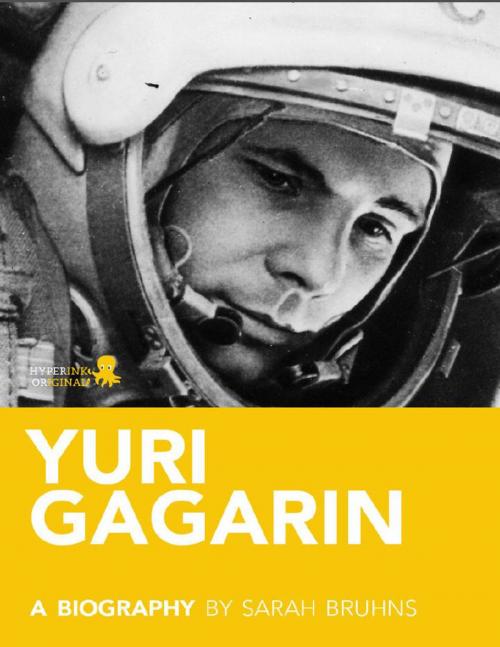| Author: | Sarah Bruhns | ISBN: | 9781614645191 |
| Publisher: | Hyperink | Publication: | July 26, 2012 |
| Imprint: | Hyperink Biography | Language: | English |
| Author: | Sarah Bruhns |
| ISBN: | 9781614645191 |
| Publisher: | Hyperink |
| Publication: | July 26, 2012 |
| Imprint: | Hyperink Biography |
| Language: | English |
On a clear, quiet day in April, 1961, two schoolgirls in Russia’s Saratov region looked into the sky and saw a huge, glowing ball hurtling towards the earth. Five tons of charred steel hit the ground, bounced, then fell again, leaving a huge smoking crater in the plains.
Two kilometers away, a peasant farmer and her daughter were frozen to the spot, staring at a bright orange figure with a large, round white head and a huge cape striding towards them. The terrified farmer and her daughter turned to run. Then the figure cried out, not in a space language, but native Russian, “Don’t be afraid! I am a Soviet like you!”
They moved closer to him and saw, instead of a alien invader or a spy, a man in an orange jumpsuit, dragging a cumbersome parachute. He pushed back the visor on his white helmet and they could see the red letters CCCP stenciled on the front. “Could it be that you have just descended from space?” asked the farmer.
The man stood only 5’2” and had the broad, plain features of a typical Muscovite. “Yes, I have,” he said, flashing his winning smile, a smile soon to be famous throughout the entire world. He said, “I must find a telephone to Moscow.”
The man had just completed a 102-minute orbit of the Earth. His name was Yuri Alexeyevich Gagarin. He was twenty-seven years old and he had changed Earth’s history forever.
“Reds Win Running Lead in Race to Control Space” screamed a headline. Since the tiny Sputnik had orbited Earth four years earlier, the United States and the Soviet Union had been locked in a battle for more advanced technologies. Both nations had immense technological resources.
The United States had imported several prominent German scientists during Project Paperclip, clearing their records of Nazi involvement in exchange for their knowledge of rocketry. The Soviet Union had the legacy of Konstantin Tsiolkovsky, the eccentric eccentric pioneer of astronautics and the de facto leadership of visionary engineer Sergei Korolev, as well was a powerful thirst to prove themselves. Each nation was determined to be the first in space. The Soviet Union’s early successes in the Space Race were an undeniable challenge to the United States’ scientific and political authority.
Yuri was born March 9, 1934 on a collective farm 100 miles outside Moscow. His mother Anna worked the fields and his father Alexei was a carpenter. Anna was well educated and kept many books in the house. For the early years on the farm, life was calm and scheduled. Family members recall Yuri as a mischievous, happy child.
Then the Nazis invaded the Soviet Union, and life was thrown into chaos. German officers occupied their home and sent Yuri's brother Valentin and his sister Zoya to slave labour camps in Poland. Yuri, his parents, and his younger brother Boris lived in a tiny mud hut for 21 months, the remainder of the German occupation. Alexei Leonov, a fellow cosmonaut and first man to walk in space, recalled this time as “the formative years in Yuri’s life.”
During the war, a Soviet aircraft was shot down near the village. Yuri and the other village children fed the pilots and kept them hidden from the Nazis until they could be rescued. It was then that Yuri knew that he wanted to be a pilot.
In 1946, when he was 13 and the war was over, Yuri’s siblings returned. Their father moved the family home (plank by plank) to the nearby town Gzhatsk. Yuri joined his school’s aviation club and learned to fly light aircraft. His favorite subjects were physics and math, and he had a smile that all the girls loved.
On a clear, quiet day in April, 1961, two schoolgirls in Russia’s Saratov region looked into the sky and saw a huge, glowing ball hurtling towards the earth. Five tons of charred steel hit the ground, bounced, then fell again, leaving a huge smoking crater in the plains.
Two kilometers away, a peasant farmer and her daughter were frozen to the spot, staring at a bright orange figure with a large, round white head and a huge cape striding towards them. The terrified farmer and her daughter turned to run. Then the figure cried out, not in a space language, but native Russian, “Don’t be afraid! I am a Soviet like you!”
They moved closer to him and saw, instead of a alien invader or a spy, a man in an orange jumpsuit, dragging a cumbersome parachute. He pushed back the visor on his white helmet and they could see the red letters CCCP stenciled on the front. “Could it be that you have just descended from space?” asked the farmer.
The man stood only 5’2” and had the broad, plain features of a typical Muscovite. “Yes, I have,” he said, flashing his winning smile, a smile soon to be famous throughout the entire world. He said, “I must find a telephone to Moscow.”
The man had just completed a 102-minute orbit of the Earth. His name was Yuri Alexeyevich Gagarin. He was twenty-seven years old and he had changed Earth’s history forever.
“Reds Win Running Lead in Race to Control Space” screamed a headline. Since the tiny Sputnik had orbited Earth four years earlier, the United States and the Soviet Union had been locked in a battle for more advanced technologies. Both nations had immense technological resources.
The United States had imported several prominent German scientists during Project Paperclip, clearing their records of Nazi involvement in exchange for their knowledge of rocketry. The Soviet Union had the legacy of Konstantin Tsiolkovsky, the eccentric eccentric pioneer of astronautics and the de facto leadership of visionary engineer Sergei Korolev, as well was a powerful thirst to prove themselves. Each nation was determined to be the first in space. The Soviet Union’s early successes in the Space Race were an undeniable challenge to the United States’ scientific and political authority.
Yuri was born March 9, 1934 on a collective farm 100 miles outside Moscow. His mother Anna worked the fields and his father Alexei was a carpenter. Anna was well educated and kept many books in the house. For the early years on the farm, life was calm and scheduled. Family members recall Yuri as a mischievous, happy child.
Then the Nazis invaded the Soviet Union, and life was thrown into chaos. German officers occupied their home and sent Yuri's brother Valentin and his sister Zoya to slave labour camps in Poland. Yuri, his parents, and his younger brother Boris lived in a tiny mud hut for 21 months, the remainder of the German occupation. Alexei Leonov, a fellow cosmonaut and first man to walk in space, recalled this time as “the formative years in Yuri’s life.”
During the war, a Soviet aircraft was shot down near the village. Yuri and the other village children fed the pilots and kept them hidden from the Nazis until they could be rescued. It was then that Yuri knew that he wanted to be a pilot.
In 1946, when he was 13 and the war was over, Yuri’s siblings returned. Their father moved the family home (plank by plank) to the nearby town Gzhatsk. Yuri joined his school’s aviation club and learned to fly light aircraft. His favorite subjects were physics and math, and he had a smile that all the girls loved.















